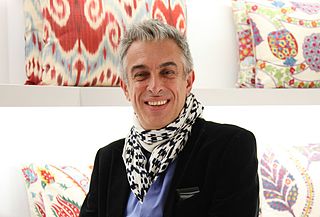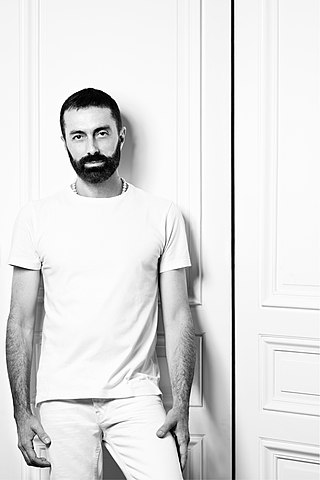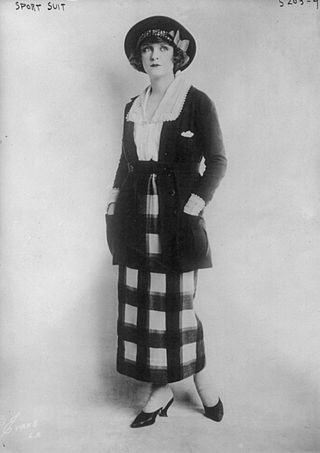
Yves Henri Donat Mathieu-Saint-Laurent, referred to as Yves Saint Laurent or YSL, was a French fashion designer who, in 1962, founded his eponymous fashion label. He is regarded as being among the foremost fashion designers of the twentieth century.

Christian Ernest Dior was a French fashion designer and founder of one of the world's top fashion houses, Christian Dior SE. His fashion house is known all around the world, having gained prominence "on five continents in only a decade."

Karl Otto Lagerfeld was a German fashion designer.

A miniskirt is a skirt with its hemline well above the knees, generally at mid-thigh level, normally no longer than 10 cm (4 in) below the buttocks; and a dress with such a hemline is called a minidress or a miniskirt dress. A micro-miniskirt or microskirt is a miniskirt with its hemline at the upper thigh, at or just below crotch or underwear level.

Count Hubert James Marcel Taffin de Givenchy was a French aristocrat and fashion designer who founded the luxury fashion and perfume house of Givenchy in 1952. He is famous for having designed much of the personal and professional wardrobe of Audrey Hepburn and clothing for Jacqueline Bouvier Kennedy. He was named to the International Best Dressed List Hall of Fame in 1970.

Valentino Clemente Ludovico Garavani, known mononymously as Valentino, is an Italian fashion designer, the founder of the Valentino brand and company. His main lines include Valentino, Valentino Garavani, Valentino Roma, and R.E.D. Valentino.

Alberta Ferretti is an Italian fashion designer and dressmaker. She designs for her namesake brand Alberta Ferretti, and designed for Philosophy di Alberta Ferretti until 2014. Her showroom is in Milan, Italy but her studio is in her native village of Cattolica, near Rimini, Italy.

Manfred Thierry Mugler was a French fashion designer, creative director and creative adviser of Mugler. In the 1970s, Mugler launched his eponymous fashion house; and quickly rose to prominence in the following decades for his avant-garde, architectural, hyperfeminine and theatrical approach to haute couture. He was one of the first designers to champion diversity in his runway shows, which often tackled racism and ageism, and incorporated non-traditional models such as drag queens, porn stars, and transgender women. In 2002, he retired from the brand, and returned in 2013 as the creative adviser.

Emanuel Ungaro was a French fashion designer who founded the fashion house called the House of Emanuel Ungaro in 1965.

Hussein Chalayan, is a British-Cypriot fashion designer. He has won the British Designer of the Year twice, and he was awarded the MBE in 2006.
The International Best Dressed Hall of Fame List was founded by fashionista Eleanor Lambert in 1940 as an attempt to boost the reputation of American fashion at the time. The American magazine Vanity Fair is currently in charge of the List after Lambert left the responsibility to "four friends at Vanity Fair" in 2002, a year before her death.
Claude Montana was a French fashion designer. His company, The House of Montana, founded in 1979, went bankrupt in 1997. He was also nicknamed "King of the Shoulder Pad," designing aggressive silhouettes which came to define the ‘power-dressing’ era of the 1980s.

Rifat Ozbek is a Turkish-born fashion and interior designer, known for his exotic, ethnically-inspired outfits. He was named British Designer of the Year in 1988 and 1992.

Shoulder pads are a type of fabric-covered padding used in men's and women's clothing to give the wearer the illusion of having broader and less sloping shoulders. In the beginning, shoulder pads were shaped as a semicircle or small triangle and were stuffed with wool, cotton, or sawdust. They were positioned at the top of the sleeve to extend the shoulder line. A good example of this is their use in "leg o' mutton" sleeves or the smaller puffed sleeves which are based on styles from the 1890s. In men's styles, shoulder pads are often used in suits, jackets, and overcoats, usually sewn at the top of the shoulder and fastened between the lining and the outer fabric layer. In women's clothing, their inclusion depends on the fashion taste of the day. Although from a non-fashion point of view they are generally for people with narrow or sloping shoulders, there are also quite a few cases in which shoulder pads will be necessary for a suit or blazer in order to compensate for certain fabrics' natural properties, most notably suede blazers, due to the weight of the material. There are also periods when pads intended to exaggerate the width of the shoulders are favored. As such, they were popular additions to clothing during the 1930s and 1940s; the 1980s ; and the late 2000s to early 2010s.

Giambattista Valli is an Italian fashion designer. He is from Rome, Italy. His collections, both ready to wear and Haute couture, are presented semi-annually during Paris Fashion Week.

Sportswear is an American fashion term originally used to describe separates, but which since the 1930s has come to be applied to day and evening fashions of varying degrees of formality that demonstrate a specific relaxed approach to their design, while remaining appropriate for a wide range of social occasions. The term is not necessarily synonymous with activewear, clothing designed specifically for participants in sporting pursuits. Although sports clothing was available from European haute couture houses and "sporty" garments were increasingly worn as everyday or informal wear, the early American sportswear designers were associated with ready-to-wear manufacturers. While most fashions in America in the early 20th century were directly copied from, or influenced heavily by Paris, American sportswear became a home-grown exception to this rule, and could be described as the American Look. Sportswear was designed to be easy to look after, with accessible fastenings that enabled a modern emancipated woman to dress herself without a maid's assistance.

Italian design refers to all forms of design in Italy, including interior design, urban design, fashion design, and architectural design. Italy is recognized as a worldwide trendsetter and leader in design. The architect Luigi Caccia Dominioni claimed, "Quite simply, we are the best. We have more imagination, more culture, and are better mediators between the past and the future". Italy today still exerts a vast influence on urban design, industrial design, interior design, and fashion design worldwide.
Maison Margiela, formerly Maison Martin Margiela, is a French luxury fashion house founded by Belgian designer Martin Margiela and Jenny Meirens in 1988 and headquartered in Paris. The house produces both haute couture-inspired artisanal collections and ready-to-wear collections, with the former influencing the designs of the latter. Product lines include womenswear, menswear, jewellery, footwear, accessories, leather goods, perfumes and household goods. Known for deconstructive and avant-garde designs with unconventional materials, Maison Margiela has traditionally held live shows in unusual settings, for example empty metro stations and street corners. Models' faces are often obscured by fabric or long hair to direct attention to the clothes and design. Margiela resigned as creative designer in 2009 and John Galliano was appointed to the role in 2014.
Phillip Bloch is an American celebrity stylist, designer, and television personality. He has styled historic cover photos including River Phoenix, which would be Phoenix's last photo shoot and the photo would be used on the cover of several magazines, and Michael Jackson for Ebony and Jet magazine. Bloch also styled the very first issue of VIBE magazine, and was featured in the film Return to Babylon and co-starred on the VH1 reality series Glam God with Vivica A. Fox.
August Getty is an American fashion designer and founder of the fashion brand August Getty Atelier.















